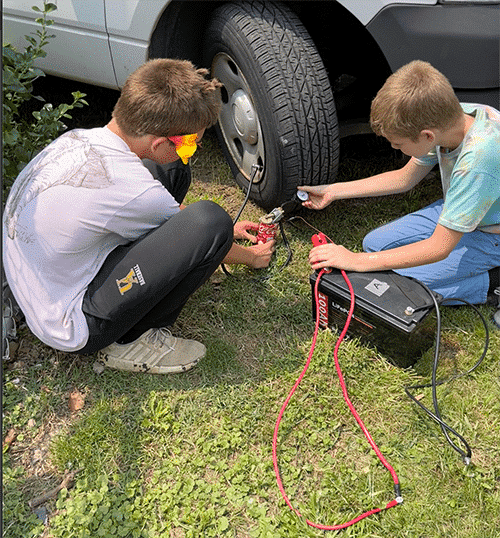The Renewable Power of Belief
Using a homemade DC powered air pump to lift a 2 ton Ford F150 truck
During a recent BioEngineering and Renewable Energy Summer Camp Mashup for the City of Columbus Parks and Recreation one of my campers sketched a vision for bridging these two disciplines. When I had the opportunity to work with Liam again, I challenged him to learn all he could about electricity, Direct Currents, and pressure. He showed up the following week with confidence in the renewable power of belief.
The previous week, Liam and his team had deconstructed a 12 V battery recharger, air pump and emergency light/SOS system. The air pump was an isolated system, as the charger and light shared a processor board (which I didn't have the manpower to teach). Liam's dream was to create a Minimal Viable Prototype (MVP) for this system.
The "Applied" in Applied STEM
It does not take a lot to create a dreamer. It takes a lot to convince the dreamer that they are right or capable. Then you have to encourage them, provide them with materials, and DEMAND that they give you blue prints and prototypes.
I challenged these kids to create MVPs to solve problems that met an engineering challenge and a renewable power mandate. Liam's device had to convert 12V and 100Ah DC current into power to run the air pump. The air pump was dangerous as there were moving parts, so it needed a casing.
Liam and his team did a great and fearless job powering the air pump up. Where they were not as successful was in understanding how to house the air pump safely and still make it accessible. They had a vision for what they wanted to create, but they had no roadmap.
The Design Cycle
Brainstorming Is Key
When I asked the team what they needed to make this work, they gave me a short list. I procured those items and set them to the task. I was surprised that they had not engineered an interior or had any plan for holding the rapidly oscillating pieces upright and still.
They were willing to put the moving pieces (rapidly spinning offset gears and pistons) of the pump loose in the PVC canister. But this damaged the pump and motor housing we would later learn. This in turn reduced the efficiency -- and lifespan -- of the pump.
Evaluate and Modify
I learned that sometimes, you have to do more than have an idea. You also need to draw and document it to see that idea as a whole.
Liam
Then we tested the pump (successfully) on a 2 ton Ford F-150 truck. The front passenger tire was going flat. Liam found a nail in the tire. We had a test case for this new solar-powered invention!
We set to designing a way to use this new tool successfully on my truck's flat tire. What we also learned was that the motor in this cheapo air pump was a brush motor. The high amperage shredded the motor brushes.
So we also learned that the system needed to have its amperage modulated (below 30 Amps). While we destroyed the motor of the air pump, We did test it successfully and we also aerated a batch of Eden's Ghost with that pump and an attached aerator stone. Compressed air has more than one use, after all!
This is the renewable power of belief. Allow kids to explore the power of Applied STEM, but require a brainstorming and baseline session to make it attainable. Then when we fail, we fail forward, and we fail well.
This is a part of the City of Columbus Parks and Recreation Summer Grant Grant #1521-2023



